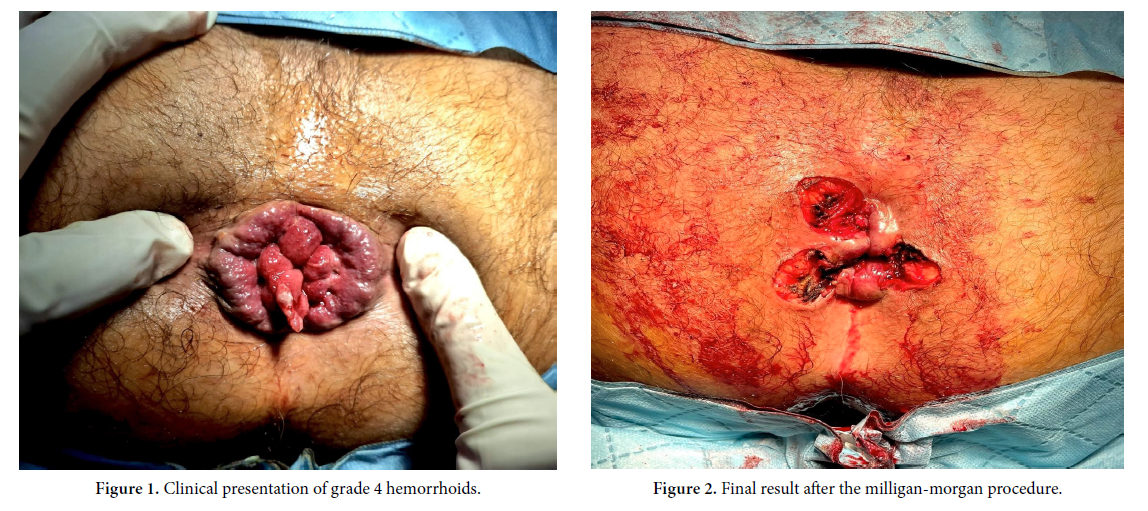2376-0249
Clinical-Medical Image - International Journal of Clinical & Medical Images (2024) Volume 11, Issue 2

Author(s): Benayad Aourarh*, Zineb Loudyi, Hicham Laraqui and Mohamed Tariq Tajdine
Department of Gastroenterology I, Mohammed V Military Hospital, Faculty of Medicine and Pharmacy of Rabat, Rabat, Morocco
*Corresponding Author:
Benayad Aourarh
Department of Gastroenterology I
Mohammed V Military Hospital
Faculty of Medicine and Pharmacy of Rabat
Rabat, Morocco
E-mail: benayad.aourarh@gmail.com, benayad.aourarh@um5s.net.ma
Received: 01 March 2024, Manuscript No. ijcmi-24-129862; Editor assigned: 04 March 2024, Pre QC No. P-129862; Reviewed: 18 March 2024, QC No. Q-129862; Revised: 23 March 2024, Manuscript No. R-129862; Published: 30 March 2024, DOI:10.4172/2376-0249.1000944
Citation: Aourarh B, Loudyi Z, Laraqui H, Tajdine MT. (2024) Surgical Management of Grade 4 Hemorrhoids: Before and After the Procedure. Int J Clin Med Imaging 11: 944.
Copyright: © 2024 Aourarh B, et al. This is an open-access article distributed under the terms of the Creative Commons Attribution License, which permits unrestricted use, distribution, and reproduction in any medium, provided the original author and source are credited.
A 50-year-old man, with no medical history, presented to our proctology unit complaining of rectal bleeding and proctalgia. He had experienced mild intermittent bleeding and anal pain for the past year. Upon clinical examination, grade four internal hemorrhoids were identified at the three, eight, and eleven o’clock positions (see Figure 1), prompting a decision for surgical intervention.
A Milligan-Morgan procedure was selected as the preferred surgical approach. This involved ligating the three pedicles followed by dissection and excision of the affected quadrants. Satisfactory hemostasis was achieved (as shown in Figure 2). The patient’s two-day hospital stay was uneventful, with no reports of bleeding, and he was discharged with analgesics to manage his mild discomfort.
Hemorrhoidal disease poses a significant social problem in the 21st century [1].
Despite the relatively common occurrence of anorectal diseases, the etiology of hemorrhoidal disease remains elusive [2].
Medical treatments are generally recommended for grade one to three hemorrhoids, while surgical options, such as excisional hemorrhoidectomy, are reserved for grade 3 and 4 cases. The Milligan-Morgan procedure continues to be regarded as the gold standard treatment for symptomatic prolapsing hemorrhoids [3].
Hemorrhoids; Milligan-Morgan
There are no conflicts of interest.
[1] Johanson JF and Sonnenberg A. (1990). The prevalence of hemorrhoids and chronic constipation: An epidemiologic study. Gastroenterol 98(2): 380-386.
Google Scholar, Crossref, Indexed at
[2] Greenspon J, Williams SB, Young HA and Orkin BA. (2004). Thrombosed external hemorrhoids: Outcome after conservative or surgical management. Dis Colon Rectum 47(9): 1493-1498.
Google Scholar, Crossref, Indexed at
[3] Gallo G, Realis Luc A, Clerico G and Trompetto M. (2018). Diathermy excisional haemorrhoidectomy–still the gold standard–a video vignette. Colorectal Dis 20(12), 1154-1156.
Google Scholar, Crossref, Indexed at
 Awards Nomination
Awards Nomination

